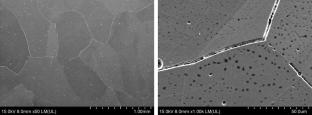Production of deformed semi-finished products from Co–Cr–Mo alloy ingots obtained with varying crystallization rates
Abstract
The work is dedicated to the study of the influence of ingot crystallization rates on the structure of formed semi-finished products obtained from Co–Cr–Mo alloy ingots. The study examines the production of ingots by vacuum induction melting with casting into molds made of different materials that provide different crystallization rates for the alloy. The homogenization annealing process and its effect on the structure of ingots with varying crystallization rates were studied. Based on differential thermal analysis, it was demonstrated that the dissolution and precipitation of excess phases in ingots with higher crystallization rates occur at higher temperatures compared to those with lower crystallization rates. The structure of the ingots after homogenization annealing and the forgings obtained from the homogenized ingots were studied using optical and electron microscopy methods. Results showed that in order to obtain deformed semi-finished products with a more uniform structure and a more homogeneous distribution of the σ‑phase, it is desirable to reduce the crystallization rate. The use of ingots obtained with a higher crystallization rate for the production of high quality semi-finished products requires a significant adjustment of the homogenizing annealing and forging regimes.


 求助内容:
求助内容: 应助结果提醒方式:
应助结果提醒方式:


